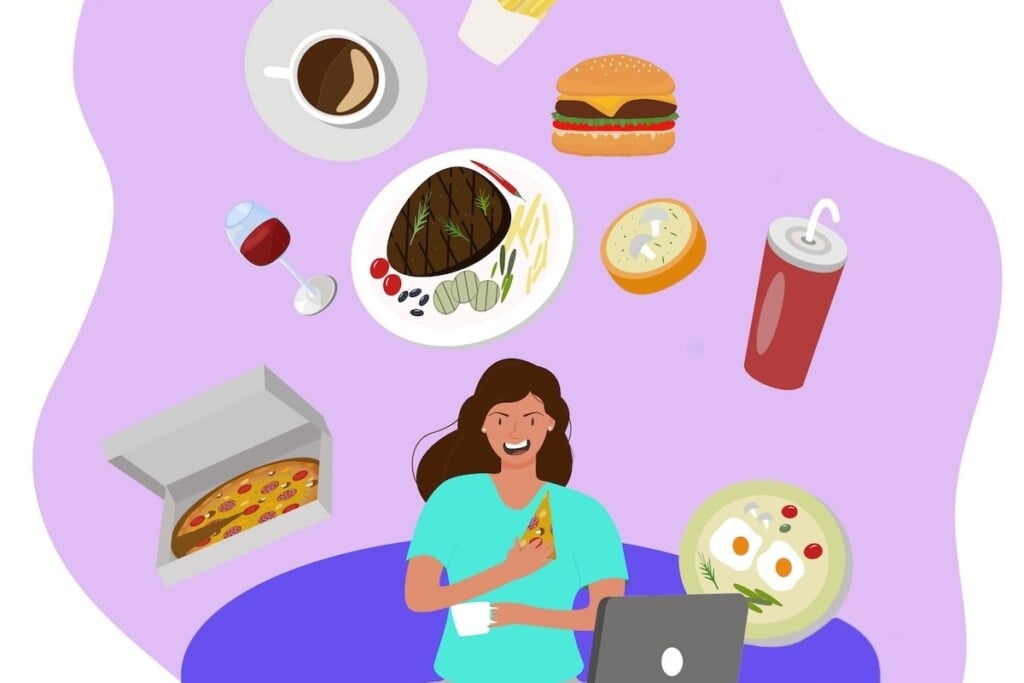The Takeout Trap
Food-delivery apps make it super-simple to order pretty much anything you'd like. But beware: there's a downside.

You’d planned to cook tonight. The chicken’s in the fridge, right next to the broccoli. But the day’s been so long and stressful, and it would be so easy just to open up that delivery app and order some pizza, General Tso’s, sushi, barbecue, burgers, Buffalo wings, tacos, pad Thai, baked ziti, chicken biryani—the list is as expansive as it is tantalizing. In fact, food-delivery apps, or FDAs, like DoorDash, GrubHub and Uber Eats, have made ordering in easier than it’s ever been, and consumers are increasingly signing on. In 2015, 66 million Americans used the apps. By 2023 that number had risen to 161 million, and it’s expected to hit 173 million by 2028.
“I love Uber Eats,” says Bella Cohn. The 28-year-old, who recently moved into an apartment in Fort Lee, says she uses the app two or three times a week, usually for dinner. “I work in New York,” she says, “and by the time I get home, I’m usually not in the mood for cooking, but I don’t really feel like going out either.” Cohn is in the demographic that has most enthusiastically embraced FDAs. According to a recent survey, 63 percent of 18- to 29-year-olds had used one in the previous 90 days, compared with 51 percent of those between 30 and 44 and 29 percent of 45- to 60-year-olds. In general, the more restaurants in an area, the more likely its residents are to use an FDA, which makes Bergen, with its 2,800-plus eateries (the most of any county in the state), prime takeout turf.
If the apps have changed the way we eat, they’ve also had a significant effect on the restaurant industry. Some 77 percent of all U.S. restaurants now offer customers the option of using an FDA, and more than a quarter of all restaurant orders are now placed online, most through FDAs. Hillsdale resident Gianna Cesa notes that one of the reasons she’s embraced DoorDash is “how easy it makes discovering new restaurants,” which helps to explain the acceptance of the apps by even upscale eateries such as Café Panache in Ramsey and Roots Steakhouse in Ridgewood.
Platforms like DoorDash, Uber Eats and GrubHub are known as aggregator apps because they act as conduits between consumers and multiple BERGENMAG.COM 40 restaurants. They’re designed to be user-friendly, allowing customers to browse dozens, if not hundreds, of menus. “I appreciate the convenient access to cuisine details and specifications,” says Cesa. “It helps narrow down options quickly based on what I’m in the mood for.”
So aggregator FDAs offer consumers great things like ease of ordering and a wider range of restaurants to order from, and they help restaurants by potentially garnering them new customers. That doesn’t mean there’s no downside to the apps’ increasing popularity. They exact a toll—and we’re not talking just about the fees and commissions inherent in every transaction. It turns out that FDAs are having a deleterious effect on many restaurants’ bottom lines and, if you’re a frequent user, could be affecting your health as well.
HOW THE APPS WORK
As a consumer, you can simply download one or more of the apps available in Bergen (including the three mentioned above as well as ChowGofer, Seamless and others), search a restaurant or a type of food (vegan, say, or TexMex) and, with a couple of taps, order food from one (or more) of many different restaurants. For a fee, most FDAs also offer subscriptions, which can earn users perks like free delivery, speedier service or special discounts.
Restaurants that choose to make their offerings available through FDAs pay a percentage of each sale, generally ranging from 15 to 30 percent, to the app companies involved in those sales. The companies also make money through delivery and service fees charged to customers. In addition, restaurants can pay to run ads on the platforms.
ARE RESTAURANTS HELPED OR HURT?
Tunc Ozlu, owner of the restaurant Cinar in Cliffside Park, has been using DoorDash and Uber Eats since they hit the market a decade ago. In the main, he says, they’ve helped his business. “They bring in traffic,” he says, “and sometimes bring me repeat customers.” Because they employ so many delivery people, they can service a large number of takeout customers in the same amount of time it used to take Ozlu’s single delivery man to service one. And they often do promotions that bring in additional customers. “The only bad thing,” Ozlu says, “is that they charge very high commissions.”
In fact, a study out of the Wharton School of Economics showed that delivery apps are hurting many establishments by increasing competition (because the apps deliver food within a wide geographic area, increasing the number of potential competitors) and shrinking profit margins with their hefty commissions. The study indicated that, because of the apps, a significant number of restaurants, especially smaller or newer establishments, have had to shut their doors due to an inability to compete and/ or make a profit.
HOW ABOUT DINERS’ HEALTH?
According to a recent Harris poll, 21 percent of Americans order food online two to three times a week, while 12 percent place online orders four to five times a week and 5 percent order online six or more times. And that has nutritionists worried. A 2021 study published in the Journal of the Academy of Nutrition and Dietetics found that people who ate takeout two or more times a day were 49 percent more likely to die of any cause over 15 years than those who ate takeout once a week or less, 18 percent more likely to die of a heart attack and 67 percent more likely to die of cancer.
Of course, most of us don’t eat takeout twice a day (with the possible exception of Gen Zers in large urban areas), but nutritionists warn that more than the occasional takeout treat can also be deleterious to health. Stacey Antine, a registered dietitian and the founder of HealthBarn USA in Ridgewood, notes that the vast majority of takeout food is high in both sodium and fat (saturated and trans fats). Sodium can contribute to hypertension and unhealthy fats to high cholesterol and cardiovascular disease. Such food “is also calorically dense, which can lead to obesity,” she says, “and portion sizes are generally larger than you’d serve at home, which can also contribute to obesity.” Obesity, of course, has been linked to type 2 diabetes and cardiovascular disease.
Fast food, says Julene Stassou, a registered dietitian in Fort Lee and author of The Mediterranean Diet Weight Loss Solution, is particularly bad for you. “It’s ultra-processed”—industrially manufactured, containing products not normally used in home cooking—“and particularly high in sodium and bad fats.” If your takeout comes in plastic containers, negative effects on health could be even more serious. A Chinese study, for instance, found that the microplastics that leach into hot foods in plastic containers are associated with a higher risk for congestive heart failure and a less robust gut microbiome, which in turn could hamper the immune system.
This doesn’t mean you need to delete your delivery apps or deny yourself the pleasure and convenience of takeout. If you love takeout but care about staying healthy, nutritionists offer the following tips:
- Take app breaks. “Make sure you get at least one healthy, home-cooked meal a day,” says Stassou, “whether that’s an egg-white omelet with vegetables; a high-fiber, low-sugar cereal with fruit or a healthy smoothie.”
- Cut down on ordering in. “Takeout,” says Antine, “is almost like an addiction, similar to ordering from Amazon,” and it’s easy to see why: A couple of taps and you’ve got a virtual banquet speeding your way, with little or no effort on your part. In fact, no less august an institution than the Cleveland Clinic offers advice on kicking what they call “a food-delivery habit” (health.clevelandclinic.org/how-to-stop-ordering-takeout). “If you’re ordering in five or six times a week, try cutting that in half,” Antine advises. “Then, a few weeks later, cut it in half again.”
- Do your homework. Check out menus of restaurants that intrigue you beforehand, so you can home in on healthier items for future ordering. That way, too, you can avoid ordering while hungry.
- Forgo the (bad) fat. Avoid foods heavy in cheese, butter and trans or saturated fats. Apps like MenuStat and FastFoodNutrition can tell you exactly what’s lurking in the menu items at chain restaurants. That way, for instance, instead of Applebee’s Chicken Tenders Platter, with its 1,410 calories, 80 grams of fat and 14 grams of saturated fat, consider ordering its TexMex Shrimp Bowl (710 calories, 27 grams of fat, 4.5 grams of saturated fat). “If you’re having soup, stick to broth-based soups like lentil and chicken noodle,” says Antine, “and steer clear of cream-and cheese-based soups like Boston clam chowder and broccoli and cheddar.” The same goes for pasta and other sauces: Opt for marinara or roast veggies over Alfredo or vodka sauce. And choose grilled or baked meats and seafood over fried.
- Go low sodium. This one’s a toughie, since even the best restaurants tend to oversalt their food. But you can certainly cut sodium intake by checking apps like MenuStat and FastFoodNutrition, asking for all sauces and dressings to be served on the side (and drizzling them judiciously), and avoiding foods that are notoriously salty such as Chinese, pizza (especially when topped with cured meats like pepperoni) and deli sandwiches containing cured or processed meats. Lower-sodium options include Mediterranean food and sushi and sashimi (minus the soy sauce for dipping).
- Get your veggies. “Try to always get a vegetable, whether it’s a salad or a soup or a vegetable on the side or double vegetables instead of pasta or fries,” Stassou advises. Consider ordering from a vegan or vegetarian restaurant (but beware of vegetarian options that are heavy on cheese and full-fat dairy).
- Find local heroes. Small local restaurants may be willing to cook to order. Don’t be too shy to ask if they can go light on the salt or switch out the butter for olive oil. (To do this, you’ll probably have to forgo the app and order by phone, but you’ll be saving your self—and the restaurant—money in the process.)
- Think small. Even if you’ve chosen a relatively healthy meal, you can undermine your health if you eat too much of it. “Don’t eat directly from the container,” warns Antine, since you can easily lose track of how much you’re eating. If the portion is large, dish out half of it onto your plate and put the rest in the fridge for another meal. Or share it with someone else—that way, you’ll be spreading the good health around.

